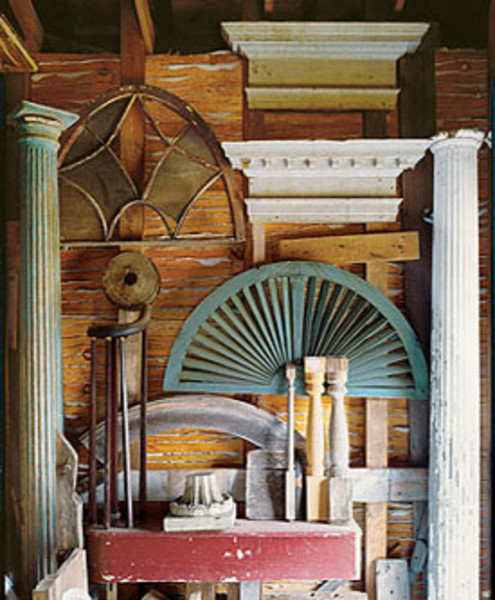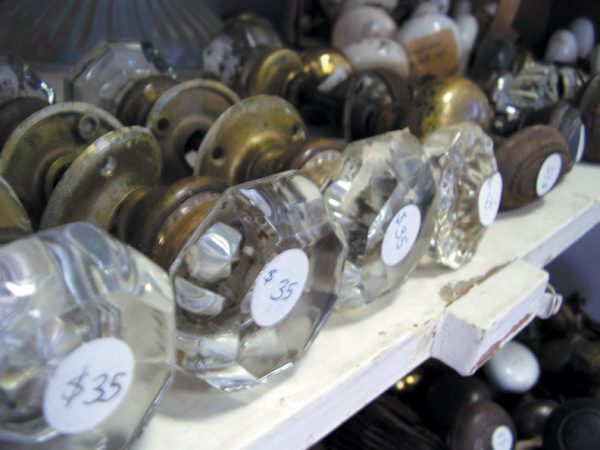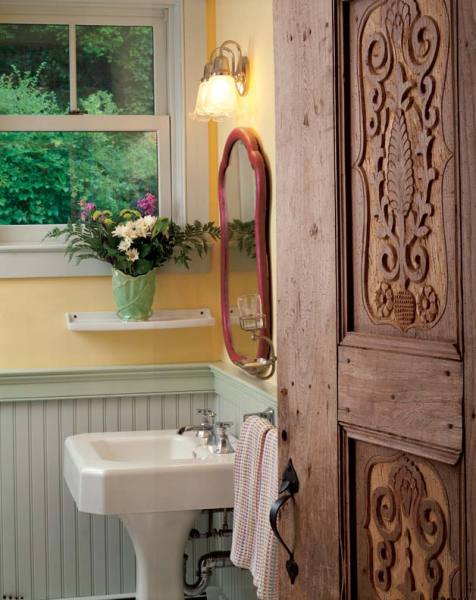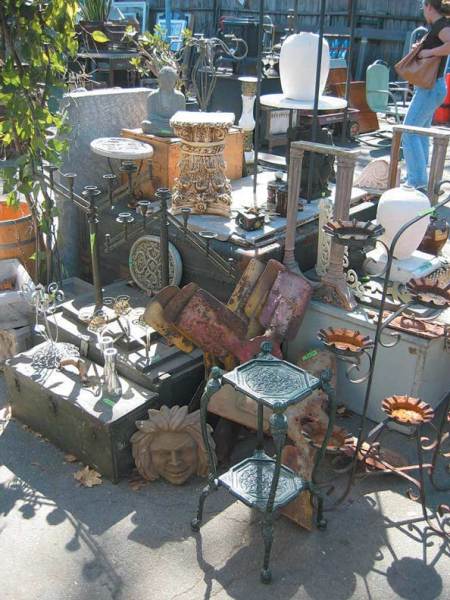While high-end dealers are making salvage shopping more convenient, nonprofit stores, whose proceeds typically benefit local preservation efforts, often have the best prices. Paul Rocheleau
For nearly three decades, the customers at Steve Drobinsky’s architectural salvage store consisted primarily of dyed-in-the-wool preservationists intent on restoring a period home down to its authentic 19th-century shutter dogs.
Then, in recent years, along came an entirely new breed of customer: suburbanites looking to replace hollow-core doors, aluminum windows, and bland cookie-cutter light fixtures in their new houses with something more solid, something with pizzazz.
“There was just this huge shift in appeal,” says Drobinsky, owner of Ohmega Salvage in Berkeley, California. The architectural salvage marketplace, once the sole province of old-house owners and a curiosity to nearly everyone else, is going mainstream in a big way. Today’s salvage and antique lumber dealers (more than 300 strong in the United States and Canada) are just as likely to sell to architects and owners of new houses as they are to those with period homes. For old-house owners, that has implications for everything from inventory to pricing as the industry responds to the demands of its newest patrons. Whether you find bargains or heavy markups when shopping for salvage depends a great deal on the era and style of your old house.
In some ways, the eccentric nature of old houses, with their nonstandard sizes for doors, fixtures, and hardware, works in your favor, as you’ll have less competition for some merchandise and more bargaining power over the price. Best of all, though, fixing up old houses has given you the skills to capitalize on another growing trend, that of do-it-yourself salvage, by harvesting architectural elements directly from the source, often houses that are the latest victims of the teardown or remodeling craze. Bob Falk, co-author of Unbuilding: Salvaging the Architectural Treasures of Unwanted Houses, calls this trend “preservation in pieces,” the next best alternative when the building itself can’t be saved.
Shop Smart
Nonprofit stores like Architectural Salvage of Greensboro, whose proceeds typically benefit local preservation efforts, often have the best prices.
Although preservationists bemoan the loss of the distinctive buildings that supply the inventory for salvage yards, the greatest appeal of architectural salvage for consumers is the chance to acquire house parts with a pedigree. “People like to point to an antique mantelpiece or flooring and say that it came from an old shoe factory,” says Rich Ellis, the founder and publisher of Architectural Salvage News. “They like the stories behind the piece.”
While you’ ll have to take the salvage dealer’s word for where the piece came from, you can be more discerning about other matters, particularly the item’s suitability and condition. Falk likens shopping for salvage to buying a used car. “You want to walk around and kick the tires a little,” he says. Given that most salvaged house parts are made of wood, consider if the species, patina, and finish are a good match for your own home. Any painted wood probably contains at least some lead-based paint and all the health hazards that accompany it. In fact, many salvage dealers won’t carry painted wood for that reason.
As for condition, if you’re buying, say, exterior doors and windows, check how weathered they are and that all parts move easily. “With doors and flooring, see how many nail holes have been pounded into the wood,” says Falk. “Have the floorboards been re-sanded, and if so, how many times?” One more sanding may leave you with nothing but the tongue and groove underneath. Look for any breaks, splits, or signs of rotting wood, and consider if the sizes, especially the thicknesses of older floorboards, fit your space. Most importantly, check for missing pieces. For instance, “you can always find parts for the interior workings of an antique light fixture, but the ornamental bits are hard to match,” says Falk.
This exquisitely carved door was salvaged from a building in Turkey. Paul Rocheleau
Once you find what you want, try negotiating a better price. “Some people will say bargaining isn’t done, but our goal is to sell the item,” says Scott Anderson, owner of Architectural Antiques in Minneapolis, which has semiannual sales to move merchandise. Salvage dealers loathe items that hang around too long, occupying valuable space in warehouses and on storeroom floors. Consequently, you’ll have the most sway over stock in architectural styles that are out of favor or in unusual sizes that won’t fit a new home. These days, Art Deco is a good buy, as is “anything from the 1940s, which you can’t even give away,” says Drobinsky.
And as tough as it is to track down a door 42″ by 75″ that fits, say, an 18th-century house, consider how much harder it is for the salvage dealer to find a customer who wants it. “The likelihood that you’ll find doors in nonstandard sizes is great,” says Jona Harvey, a personal salvage shopper and the owner of Salvage Search and Management. “The salvage guys are just sitting on that inventory because new-house owners, whose houses have to meet modern building codes, can’t really use those doors.” On the other hand, expect to pay top dollar for anything Arts & Crafts, Queen Anne, or Tudor, all hot architectural styles right now. Antique brick and lumber, the fastest growing areas of the salvage industry, are also in great demand and fetch steep prices.
The Home Depot Effect
Don’t overlook salvage yards—such as this one at Ohmega Salvage—as a resource for finding the architectural accents that were once common in an old-house garden, such as statuary, stone pedestals, and cast-iron fences and gates.
One consequence of architectural salvage’s broader consumer appeal, particularly at high-end stores, has been to make shopping easier and more convenient for everyone, regardless of a house’s age or style. Some upscale salvage dealers now sell merchandise in complete sets, instead of everything à la carte, saving you the trouble of hunting down each piece individually. Anderson, for instance, only sells salvaged doors with the jambs. “Home Depot has spoiled a lot of people because you’ll get a door in the jamb,” he says. The same practice applies to antique doorknobs, which Anderson sells with the matching hinges and mortise locks.
Perhaps the biggest change in salvage is the sale of entire rooms—from the wood paneling to the French doors to the marble fireplaces—that have been dismantled from old houses and come with detailed blueprints for reassembly. Anderson sold a walnut-paneled Georgian room from the Morton Salt estate for $75,000. Although architects often buy the rooms and incorporate them into the design for a new house, they also have potential as one-stop shopping for anyone enlarging an old house with a period-sensitive addition.
No More Middleman
At the other extreme from high-end stores lies a different kind of one-stop shopping—laying claim to architectural elements in houses slated for demolition or remodeling. Salvage dealers do it all the time, but on a much larger scale, by buying the salvage rights to a building, a practice that is prohibitively expensive for the average person who wants to acquire only one or two pieces. An individual, however, can approach a homeowner, contractor, or a demolition company and come to some arrangement about removing only the items desired for hundreds of dollars, even for free, says Falk. For a quality mantelpiece, which can retail at a salvage store for $1,500 or more, the savings can be significant because you eliminate the middleman. Instead, you dismantle the item and haul it away yourself, often on short notice.
To spot opportunities for “deconstruction,” as it’s known in the industry, keep an eye on redevelopment in your community, where the houses are likely to be of a similar age and style as your own and a good match for salvaged material. Find out from neighbors about upcoming or ongoing remodeling projects, or make friends with the staff in your local building department. “When permits for demolition come up, contact the contractors, who can save money if you do some of the work for them,” says Falk. Then get everything in writing. Specify on paper what you will and won’t do and by when, and make sure all parties sign it.
In a handful of cities, some companies secure the rights to salvaging properties, some of which are old homes, and then hold public auctions on site for buyers to bid on the architectural features. The winning bidder removes and takes away the piece that day, and “the buyer can get some real deals, too,” says Falk. Chicago-based Murco Recycling helped pioneer the concept more than a decade ago and is considering expanding the business nationally. Whichever approach you choose, extracting the items yourself assures you of pieces whose provenance you know, as well as the stories of what it took to save them for reuse in your own home.







